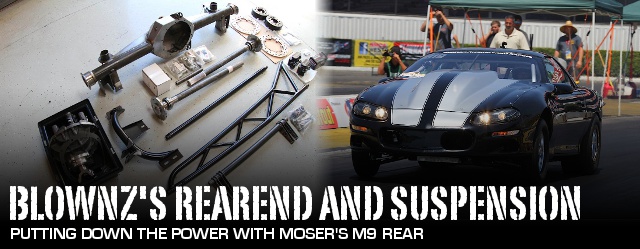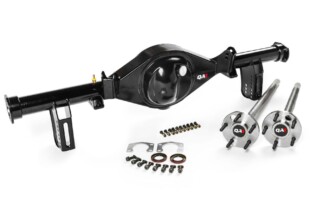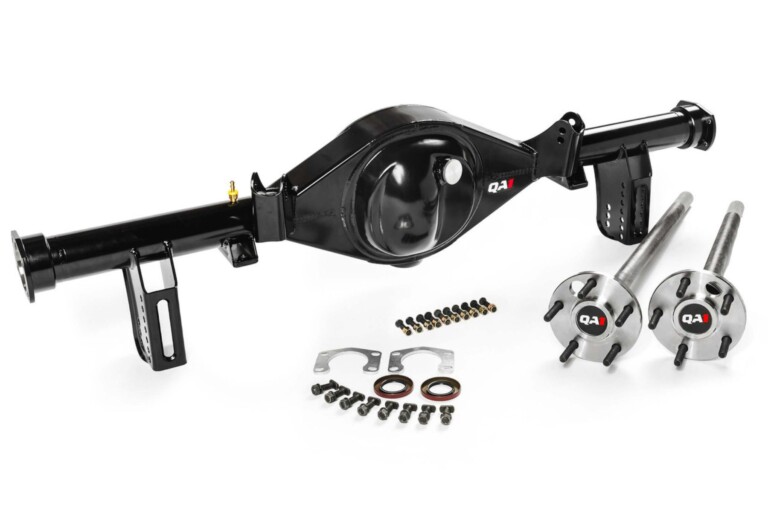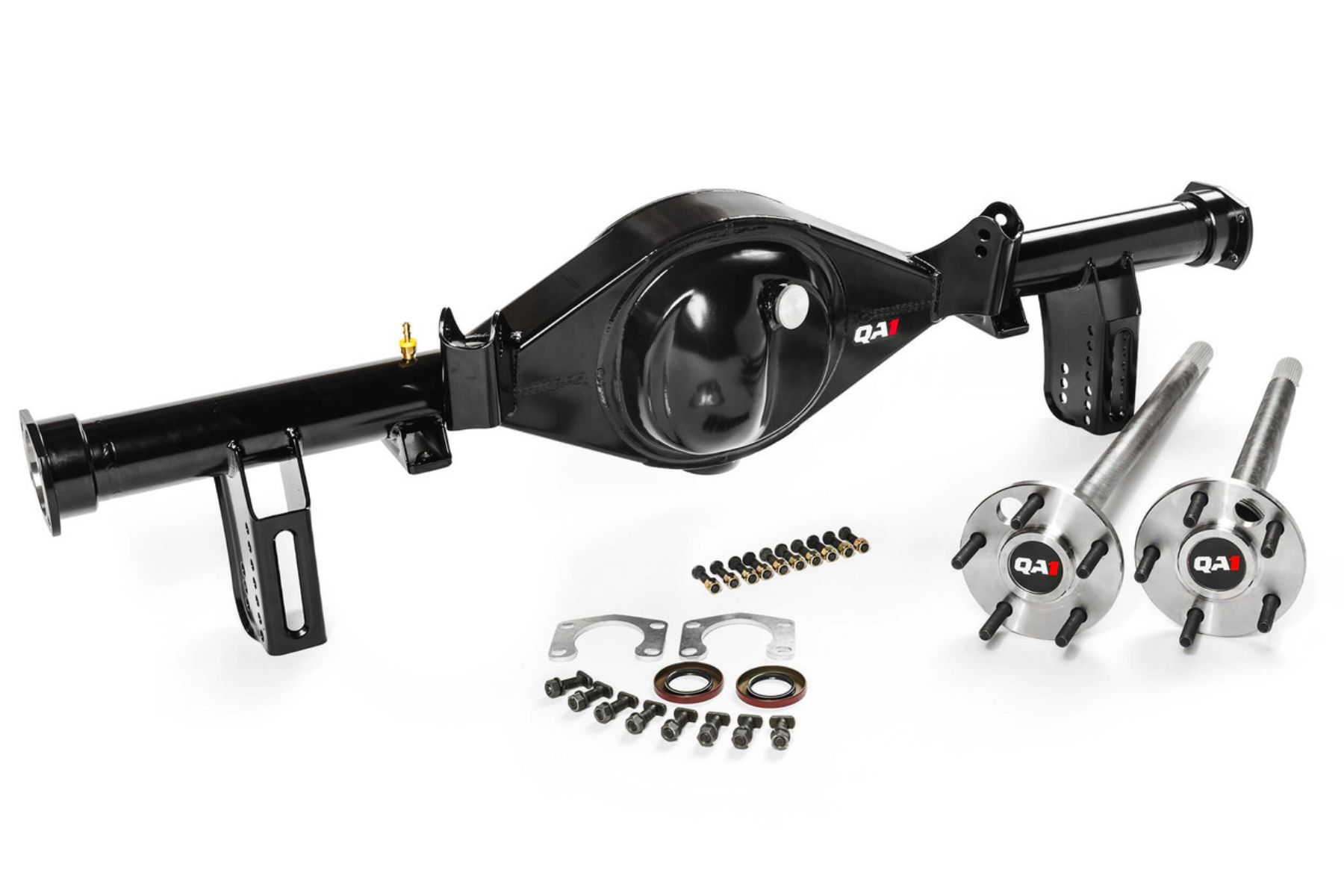In many ways, Project BlownZ is a car of contradictions. We have no intentions of driving our black 4th Gen Z28 on the street, but yet we plan to use a stock style suspension and small 275 radials to hook up nearly 1,300 ProCharged ponies from our race-bred 388ci LSX at the drag strip. Some folks might think it would be easier to do a full tub job and fab up a triangulated 4-link for our race-centric purposes, but we say where’s the fun in that?
Ultimately, choosing to go the drag radial route with a stock-style suspension means we’ll be on a constant mission for traction. In our last installment we discussed how we plan to set the weight transfer to the rear tires in motion with our front suspension, and this time we’ll focus on the area where most of this time and effort is aimed – the rear of the car. Squeezing every ounce of traction from our 275 M/T’s will be a challenge that calls for some super strong and infinitely adjustable components, and will test all the suspension tuning tricks we know.
Moser M9 Fabricated Rearend Housing
We’ll start with the foundation for the rear half of BlownZ – the Moser M9 rearend (Part # 9M). The reason we went with the fabricated M9 housing is a simple one: unmatched strength. Regular stamped Ford 9-Inch or Chevy 12-Bolt housings weren’t designed to take a direct blow from well over 1,000 pound feet of torque. So, we needed a rearend that was up to the challenge. Jeff Anderson, from Moser Engineering tells us, “Typically any fabricated housing will offer greater resistance to distortion and flex than a stamped unit because of the geometry that goes into countering the flex of a heavy torque load.”

From the triangulated one-piece center can to the fully welded back braces, the M9 just oozes with toughness.
Moser fabricates the M9 starting with a single piece of 1/8-inch thick mild steel, that is triangulated and laser cut to form the center can. “Instead of welding several parts together and hoping for the best, you have a perfect geometrical design from the very beginning,” says Anderson. “This means that the housing’s strength hasn’t been affected by weld depth or over-heating in the way a multi-part center can could be.” From there, Moser adds a 3/8-inch thick faceplate, 3-inch O.D. seamless tubes made of ¼-inch wall steel, and back-bracing to the M9 for even more rigidity. To say that the M9 is “beefy” would be a huge understatement.
Moser sent us our M9 all welded up and with the necessary suspension brackets already in place.
Moser Nodular Ford 9-Inch Center Section
For the center section, we had Moser build us a nodular iron 9-inch (Part # 3M) with a lightened Pro Steel 40 spline Spool. “Not only is a spool an economical and safer way to lock the axles together, it will also save rotational weight over a more traditional or modified carrier,” says Anderson. “Depending on the carrier and type of rearend you could be looking at dropping nearly 20 or 30 pounds of rotational weight. It’s the strongest and most reliable way to deliver power to the ground effectively.” For gears, we determined that Moser’s Pro/Comp ring and pinion in a 3.50 ratio would be a good match for our TCI Pro-X Powerglide, our rear tire height, and the characteristics of our 388 LSX.
Our 9-Inch center section consists of a nodular iron case wrapped around Moser's light-weight Pro Steel Spool for 40-spline axles and a set of 3.50 gears. The pinion yoke is a 1350 series held in by Moser's aluminum Daytona Pro/Street pinion support.
Moser 40-Spline Axles
Our axle choice was dominated by two major factors that are inherently linked; safety and strength. We picked a set of Moser’s 40-spline alloy axles (Part # A40CST), which feature a huge diameter of 1.705-inch on the working end, and an oversized bearing seat diameter of 1.774-inch for even more strength. By using these large diameter axles, we’ll be increasing our torque capacity and moving the any potential failure point further along the driveline to the next weakest link.

We weren't messing around when it came to the business end of our M9, so we had Moser use a set of their massive 40-Spline alloy axles.
As you might have already guessed, these axles don’t use C-Clips. “The C-Clip is a common failure point in production cars,” Says Anderson. “Once it does fail, the axle can and eventually will start exiting the housing. In fact, the use of non C-Clip axles is mandated by most sanctioning bodies when cars start exceeding certain MPH marks.”
You’ll also notice some very serious wheel studs poking out the flanges of our axles. Those are 5/8-inch chromoly studs, because when we’ve gone this far, why would we take a chance on the only hardware that keeps the wheels bolted to the car?
We've got plans to be trapping well over a buck-fifty in BlownZ, so no puny c-clip axles for us.
Moser Rear Drag Brakes
Unlike a street car which does most of its braking with the front brakes, the rear brakes in a drag car are the real work horses. The brakes slow the motion of the wheels, but the friction from the tires is what actually slows down the car. The front skinnies do wonders for reducing rolling resistance, but they won’t do much if we try to use them to haul down BlownZ from 150-plus miles per hour. So, the brake bias has to be shifted to the rear tires, where the slicks can do the vast majority of scrubbing the top end speed.

Moser's Perfomance Dynamic drag brakes use 4-piston calipers constructed of all t6 billet aluminum. Purty, ain't they?
We elected to use Moser’s new Performance Dynamic Drag Brake Kit (Part # 2600-12500-B) with a set of Hawk Black brake pads. The four piston calipers are made from 6061 T6 billet aluminum for high strength to weight ratio and use stainless pistons. The rotors use a cool new dynamic disc and hat design which uses a keyed hat that holds the rotor on with a snap-ring. “We not only designed them for safe and repeatable braking but also for ease of service for racers,” says Anderson. “A key to this kit is the ease of maintenance if you need to change a pad or rotor. The dynamic mooting literally makes it a simple operation because you don’t have to worry about frozen bolts sticking a rotor and hat together at the track. We also don’t have the warping common to other kits because of our dynamic mounting design.” Check out our full install tech article on the Moser Drag Brakes here for even more info.
Rather than bolting the rotor to the hat like most drag brake kits, Moser uses unique keyed hat with a snap-ring. No bolts to freeze up means easier servicing.
Moser Torque Arm Suspension and Pan-Hard Bar
BlownZ’s Rearend and Rear Suspension
Moser M9 Fabricated Housing -Part # 9M
Moer 40-Spline Axles -Part # A40CST
Moser 9″ Center Section – with Pro-Steel Spool and Pro/Comp 3.50 Gears -Part # 3M
Moser Adjustable Torque Arm -Part # 737009
Moser Adjustable Lower Control Arms -Part # 737100
Moser Adjustable Panhard Rod -Part # 737101
Moser Performance Dynamic Rear Drag Brake Kit -Part # 2600-12500-B
Afco “Big Gun” Double Adjustable Coilovers -Part # 3870-RBG
Wolfe Racecraft Double Adjustable Rear Sway Bar -Part # FWOL102
Mickey Thompson Pro-5 15 x 12 Rear Drag Wheels -Part # 5125547
Once we had our bomb-proof M9 all sorted out, it was time to focus in on how we’d keep it suspended under BlownZ, and get our smallish 275 drag radials hooked at the same time. We went with Moser’s fully adjustable torque arm for our M9 (Part # 737009) along with their adjustable lower control arms (Part # 737100), and adjustable panhard rod (Part # 737101). Hopefully you can see a common pattern among the Moser F-body rear suspension parts, because adjustability is the name of the game. “We actually developed this kit around a Pro Mod style setup for the radical applications and horsepower tuning combinations being utilized today,” says Anderson. “This setup will give a drag radial car so many options for setting up the suspension that it is literally possible to not only tune for the power, but also for the tire manufacturer and compound types.” Suspension tuning takes a lot of time to build data for a car, and we’ll be keeping plenty of notes, but it’s nice to have an almost limitless amount of options for tuning and adjustment.
Of course, all the suspension tuning in the world won’t do us any good if our parts are distorting and flexing off the line. Anderson tells us, “All these components are constructed form 4130 chrome-moly material that is pretty much indestructible and isn’t going to flex. You will damage something else long before the torque capacity of these parts is surpassed.”
Just because all these parts are “stock type” doesn’t mean that we just bolted them in the OEM locations and called it good-enough. Our fabricators took the extra time making sure everything was just right, including really strengthen the panhard mounting box ensuring that we had the optimal geometry to keep the rearend as centered as possible. We also had to clearance the floor pan a decent bit to clear the torque arm under full compression.
The Moser torque arm suspension is configured in essentially the same way as the stock F-body suspension. The torque arm bolts to the rear end housing on one end, and an adjustable crossmember at the other. Besides being made of indestructable chrome-moly, the biggest benefit is the vast amount of adjustability that is built into every component.
While we had the welder out, we installed our double rear sway bar from Wolfe Racecraft (Part # FWOL102). The Wolfe sway bar is made of chrome-moly tubing, and the arms ride on machined aluminum bushings that won’t bind. The Wolfe unit is welded between the stock frame rails, and attaches to the rearend with two adjustable spherical rod-ends on each side.

Our double rear sway bar from Wolfe Racecraft will allow us to put as much preload as we need on the rear suspension to give a drama-free launch.
Even though it doesn’t look like a stock sway bar, it still serves the exact same purpose: to eliminate body roll. For BlownZ, this will mean straighter, flatter, and more consistent launches. By welding in the Wolfe sway bar and using spherical rod ends, there is absolutely no slop, and a good bit of preload can even be applied with the rod-ends. In fact, the biggest advantage of having two connections on each end to the M9 is that we can use the adjustable rod ends to work against each other and completely eliminate body roll.
We spent quite a bit of time welding in the Wolfe double sway bar, as well as strengthening the panhard rod box.
Afco “Big Gun” Double Adjustable Shocks and Springs
Any time you turn the tire loose it’s hard to get it hooked back up, especially with drag radials. They need to get hooked and stay hooked. -Eric Saffell, Afco
It’s nearly impossible to over-stress the importance of having the right shock and spring combo in a drag application. This is an area where we’ll also need a great deal of adjustability, so we picked up some of AFCO’s double adjustable shocks (Part # 3870-RBG), with their “Big Gun” valving. Eric Saffell, Drag Racing Product Manager at Afco tells us, “The term ‘Big Gun’ references the valving, which is specifically designed to control high horsepower applications, especially those still using a stock-type suspension.”
The nitty gritty of getting the car hooked is in the shock valving. There are a lot of movements taking place in the rear suspension and rear axle as the car launches, and the shock’s extension and dampening rate have to take all of them into account. If you watch a drag car launch, you see the front end lift up, the back of the car squats, and the car launches. To our eyes this all seems to happen at roughly the same time, but there’s more to it. Saffell tells us “What we’ve observed during data acquisition is that as the rotation occurs, the rear suspension linkage tries to plant the tires down, and lifts up on the chassis. The shock’s first motion is actually extension. We aren’t so much trying to stop that initial extension as we are trying to control it. We want to control he amount of separation and its speed.”

Afco designed their Big Gun shocks for cars just like BlownZ that are making big power and still using a stock based suspension.
As the weight transfer from the front of the car is applied, it’s vital to properly dampen the rear suspension movement. If we get greedy and apply too much downward force to the tire, we’ll find ourselves victims of physics; every action has an equal and opposite reaction. The tire will bounce back like a basketball snapping back to your hand after you dribble it too hard. Ultimately, we want the tire to take the initial hit, and be able to absorb it through sidewall flex as it grips the track.
We kept the stock configuration of a separate shock and spring rather that using a full coilover, but the adjustable spring top still gives us plenty of ride height adjustment. Because BlownZ will be so much lower than stock, we used a an Afco shock that is also 1-inch shorter so we still have all the shock travel we need without bottoming out.
For the rear springs, we used a set of Afco’s adjustable ride-height springs, since 4th Gen F-Bodies don’t really use a true coilover set up. Ultimately they are there to just hold up BlownZ’s weight. We used a spring with a low rate to keep the rear suspension soft enough to let the shocks and suspension do their job, and be more forgiving on any irregularities or transitions on the track’s surface.
Mickey Thompson Pro-5 Rear Drag Wheels
We’ve worked our way through our entire rearend and rear suspension, now it’s time to put some rubber on the road. For wheels, we picked up a set of 15 x 12 Mickey Thompson Pro-5 drag wheels (Part # 5125547) that are a trick one-piece design constructed out of T6 forged aluminum. In addition to being ultra-tough and light weight, the Pro-5 wheels are 15.1 SFI certified for drag racing. “We went with a one-piece design because we could make it stronger and lighter on a molecular level than a two or three-piece wheel because there are no intersect points, welds, or hardware,” says Carl Robinson, designer at Mickey Thompson behind the Pro-5.

The one-piece forged construction of the Pro-5 wheels means less weight and even more molecular strength.
A cool feature of the Pro-5 wheels is that they are designed to use both a Double-D lock and wheel screws. The lip on the back of the wheel comes pre-dimpled from M/T in the exact locations for the wheel screws used with M/T tires. Finally, at the receiving end of all that power and torque produced by our ProCharged 388ci LSX, is a set of tried and true Mickey Thompson drag radials.
No need to guess where to drill for your wheel screws. M/T already has dimpled the Pro-5 wheels in the right spots for their tires.
We knew this wasn’t an easy path when we started down it. We knew that physics would be working against us every time we tried to feed 1,300 horsepower through a stock type suspension and some barely wider than stock drag radials. Our mission for traction and high 7-second ETs is going to mean long hours at the drag strip, dialing in and fine tuning the chassis, but we know we’ve got the right parts in the right places to get us exactly where we want to be.

Here you can see all the components welded in and all buttoned up. So far, our M9 and all the rest of the parts in the back end of BlownZ have performed flawlessly no matter how hard we beat on them.








































